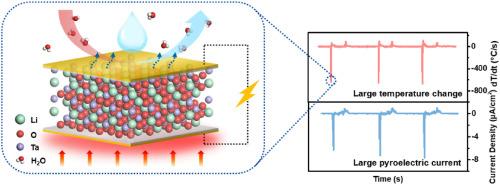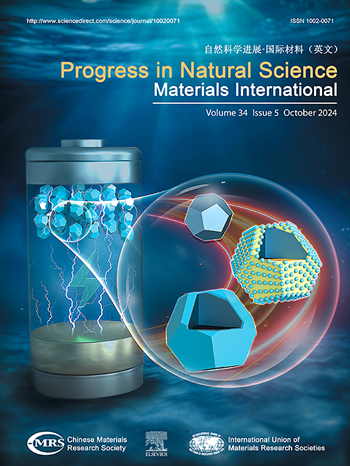Large pyroelectric current generation induced by droplet cooling
IF 4.8
2区 材料科学
Q2 MATERIALS SCIENCE, MULTIDISCIPLINARY
Progress in Natural Science: Materials International
Pub Date : 2024-10-01
DOI:10.1016/j.pnsc.2024.07.006
引用次数: 0
Abstract
This paper demonstrates an alternative and simple approach for achieving a fast temperature change on a pyroelectric system through droplet cooling, which leads to enhancement in pyroelectric current generation. The pyroelectric system was composed of a pyroelectric layer of lithium tantalate (LiTaO3) that was sandwiched between two layers of gold/titanium (Au/Ti) as the top and bottom electrodes. Due to both high latent heat and sensible heat of water, there was a rapid heat exchange during the droplet cooling process, and the pyroelectric layer underwent a fast temperature change with the maximum rate of ∼725 °C/s. The induced pyroelectric current density reached as high as ∼8.8 μA/cm2. Such pyro-current density is among the highest reported so far. The pyroelectric response was also investigated by using the surfaces with different wettability. The hydrophilic surfaces underwent faster heat dissipation, leading to the generation of larger current than that of the hydrophobic surfaces during the droplet cooling process. This work may help expand the utilization of pyroelectric materials in various applications that involve the current generation using pyroelectric effect.

液滴冷却诱导产生大热释电电流
本文展示了通过液滴冷却实现热释电系统快速温度变化的另一种简单方法,从而增强热释电电流的产生。热释电系统由钽酸锂(LiTaO3)热释电层组成,该层夹在作为上下电极的两层金/钛(Au/Ti)之间。由于水的潜热和显热都很高,液滴冷却过程中热交换迅速,热释电层的温度变化很快,最大变化速率可达 ∼ 725 °C/s。诱导热释电电流密度高达 ∼8.8 μA/cm2。这样的热释电电流密度是迄今为止所报道的最高电流密度之一。我们还使用不同润湿性的表面研究了热释电响应。在液滴冷却过程中,亲水性表面散热更快,产生的电流比疏水表面大。这项工作可能有助于扩大热释电材料在涉及利用热释电效应产生电流的各种应用中的利用。
本文章由计算机程序翻译,如有差异,请以英文原文为准。
求助全文
约1分钟内获得全文
求助全文
来源期刊
CiteScore
8.60
自引率
2.10%
发文量
2812
审稿时长
49 days
期刊介绍:
Progress in Natural Science: Materials International provides scientists and engineers throughout the world with a central vehicle for the exchange and dissemination of basic theoretical studies and applied research of advanced materials. The emphasis is placed on original research, both analytical and experimental, which is of permanent interest to engineers and scientists, covering all aspects of new materials and technologies, such as, energy and environmental materials; advanced structural materials; advanced transportation materials, functional and electronic materials; nano-scale and amorphous materials; health and biological materials; materials modeling and simulation; materials characterization; and so on. The latest research achievements and innovative papers in basic theoretical studies and applied research of material science will be carefully selected and promptly reported. Thus, the aim of this Journal is to serve the global materials science and technology community with the latest research findings.
As a service to readers, an international bibliography of recent publications in advanced materials is published bimonthly.

 求助内容:
求助内容: 应助结果提醒方式:
应助结果提醒方式:


